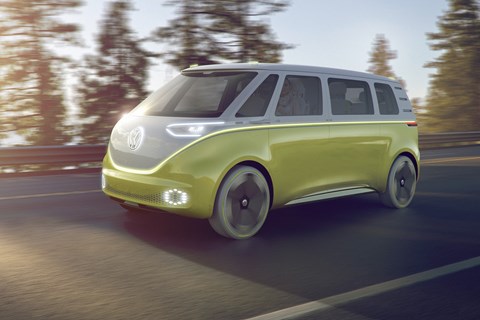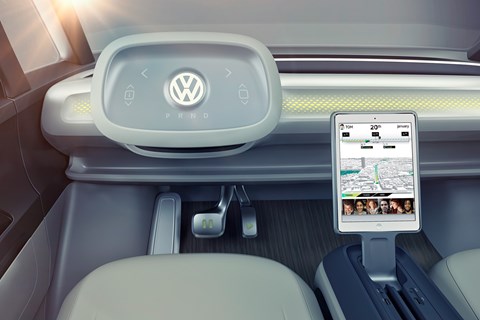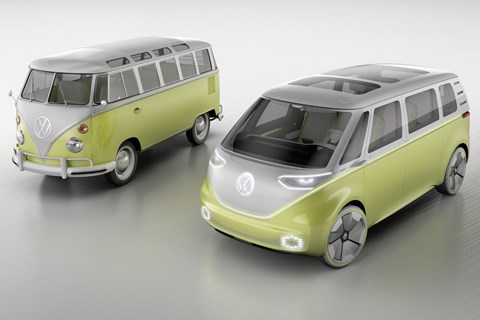► Electric van concept at Detroit show
► Fully autonomous driving capability
► Riffs on classic Microbus design cues
Volkswagen continues to throw its marketing and technical weight behind EV and autonomous models, with a new self-driving electric van concept displayed at the 2017 Detroit motor show.
The Volkswagen I.D. Buzz concept van is designed to show off the capabilities of the VW Group’s new MEB electric car platform, which will enter production in 2020 with a new compact EV hatchback model. The I.D. Buzz van remains a concept for now, but demonstrates the flexibility of the MEB platform for potential future production models.
There’s been a VW I.D. concept car before, hasn’t there?
The I.D. Buzz follows on from the Volkswagen I.D. concept shown at the 2016 Paris motor show, which more closely previews the production compact car planned for launch in 2020.
Read all about the 2016 VW I.D. concept here

The I.D. Buzz concept, then – what’s the story?
In a nutshell, a larger version of the I.D. concept with a retro-futuristic body riffing on the classic VW Microbus – a little like the BUDD-e concept shown at CES 2016.
A few highlights:
- Seats eight
- Pure EV, all-wheel-drive. Two electric motors, one front, one rear.
- Total system output 275kW (equivalent to 368bhp)
- VW projects a speedy 5sec 0-62mph time, with top speed governed to 99mph.
- 270-mile range
- Augmented reality head-up display
VW is shouting more loudly than previously about electric and autonomous technology in a continued effort to reposition its brand identity in the wake of 2015’s ‘dieselgate’ emissions scandal.
‘The Volkswagen brand’s big electric offensive begins in the year 2020 with a completely new vehicle architecture,’ says Dr. Herbert Diess, VW board chairman.
‘That is when we will be launching an entirely new generation of fully connected, all-electric vehicles on the market. By 2025 we want to be selling one million of these vehicles annually. We are making electric mobility the new trademark of Volkswagen.’

This vehicle’s autonomous, you say?
A combination of lasers, radars, ultrasonic sensors and cameras enable the concept to theoretically take care of driving all by itself.
In full robo-drive mode, which VW calls ‘I.D. Pilot’, the driver’s seat can be turned 180 degrees to face the rear passengers.
A slight push on the bizarrely shaped steering wheel causes it to retract into the dashboard, and decouple from the steering gear. Touching the wheel or pedals deactivates autonomous mode and allows the driver to reassume control.
VW says a fully autonomous drive mode of this type would be ‘conceivable starting in 2025.’
What’s this augmented reality head-up display business?
It projects 3D information graphics (such as navigation direction arrows) onto the driver’s view of the road on the windscreen, appearing a virtual 7m to 15m ahead.
More information is displayed upon the inevitable touchscreen, a removable tablet on the centre console. Further touchpads in the rear of the cabin control the passengers’ climate control settings.
Even the steering wheel (or steering rectangle) itself is a touchpad, with capacitive sensors in place of switches. No self-respecting concept car would be seen with physical buttons these days – they’re so passé.
There’s no start button; the driver presses the brake pedal (confusingly marked with a ‘pause’ symbol, puts the van in gear and drives off. Pressing the ‘P’ button on the steering wheel switches the vehicle off, and the wheel automatically retracts back into the dash.

Those headlights look interesting…
The Buzz’s ‘eyes’ change expression according to whether it’s parking, in autonomous or manual mode, or to greet the driver as they approach the vehicle.
Where do the batteries go?
The lithium-ion battery is integrated into the floor, freeing up plenty of space inside for people and luggage (for which there are two separate compartments).
While the dual-motor I.D. Buzz concept is all-wheel-drive, the MEB platform could just as easily allow front- or rear-wheel-drive configurations. It’s designed to be manufactured on the same production line, and to share its suspension layout with, existing ‘MQB’ platform combustion engine models such as the Golf.
Wheelbase is a generous 3300mm, showing the platform’s flexibility, and a wide turning angle for the front wheels enables a usefully titchy sub-11m turning circle.
VW I.D. Buzz: full tech specs
- Length: 4941 mm
- Width: 1977 mm
- Height: 1963 mm
- Wheelbase: 3300 mm
- Track width, front: 1728 mm
- Track width, rear: 1707 mm
- Turning circle: 10.73 m
- Wheels / tires 235/45 R22
- Electric motor, rear: 150 – 200 kW (204 – 272 PS)
- Electric motors, all-wheel drive: 150 kW (204 PS), front and rear
- System power, all-wheel drive: 275 kW (374 PS)
- Acceleration, 0-100km/h: 5.3 s (all-wheel drive)
- Acceleration, 0-60 mph: 5.0 s (all-wheel drive)
- Top speed: 160 km/h / 99 mph (limited)
- Battery energy capacity: 83 – 111 kWh
- Charging power: 150 kW (DC); 11 kW (AC / Inductive)
- Battery charging to 80% SOC: approx. 30 min. (15 km/min)
- Driving range (EU; NEDC): 450 – 600 km
- Driving range (USA; AER*): 200 – 270 mi
*AER = All-electric Range
Click here for more from the 2017 Detroit motor show
